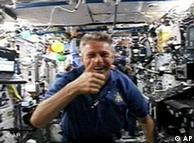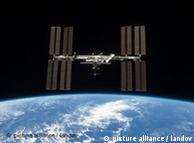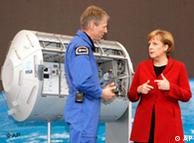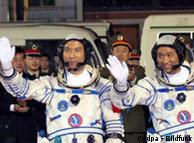Future of space exploration is bright, German astronaut says
In a DW interview, former astronaut Thomas Reiter says the space shuttle
program's end is just a 'bottleneck.' The European Space Agency
official adds that China and India are rising space powers as well.
As the space shuttle program winds down, the European Space
Agency is working on its new generation of spacecraft and future manned
space missions. To learn more about European space science, Deutsche
Welle turned to Thomas Reiter, one of Europe's most experienced
astronauts. During the 1990s, he spent nearly six months on the Russian
space station Mir. Then, in 2006, he spent another half a year on the
International Space Station. In April 2011, Reiter became the head of
the European Space Agency's Directorate of Human Spaceflight and
Operations.
Deutsche Welle: Five years ago, you flew on the space shuttle
Discovery to the ISS and returned safely back to Earth. What do you
remember most about this trip?
Thomas Reiter: I have only positive memories. It's tempting to
compare that trip with my trip on the Russian Soyuz, which I flew on 14
years earlier. The space shuttle is, of course, a bit more comfortable.
 Thomas Reiter served aboard the International Space Station in 2006 Thomas Reiter served aboard the International Space Station in 2006
There's much more room, both going to and coming back from the space
station. Even re-entering the Earth's atmosphere is more comfortable as
the gravitational acceleration during re-entry is not as high. On the
space shuttle it's only 1.5 times the force of gravity, while on the
Soyuz, it's four times. And after six months of weightlessness in space,
that's quite a difference.
Now that the space shuttle
program is over, the only way NASA can carry people into space will be
via the Russian Soyuz capsules. Are they not an adequate replacement?
They serve their purpose as a means of transportation. Even though
it's not particularly comfortable, it does go up and comes back down
again. The point is to make it safely to the International Space
Station. And this can be done by the Russian Soyuz capsules too. But, it
can hold far less cargo. That's the crucial point, because the shuttle
could carry seven people in the cargo bay along with a payload of 20
tons into space and back.
For scientific samples that are processed on board the ISS, this
reduction in carrying capacity is obviously a loss. But now that the
shuttle has been discontinued, we will survive with this bottleneck for
three to four years.
The space shuttle will be replaced by private commercial operators. Should we rely on them?
It is an important step, to use commercial firms for such tasks. And I
think the entire space community is looking with great interest
worldwide towards this experiment. I have no doubt that it is possible
for this limited task. However, one can not solely depend on using such
providers over the long-term. Maybe other options will be possible in
ten or fifteen years.
At the moment it is important to have a combination of new private
companies as SpaceX, which must still prove that they can provide these
services, and established institutional facilities such as the shuttle
or the Soyuz. The ISS will be there until at least 2020.
 The International Space Station will temporarily only be serviced by the Russian Soyuz capsuleDoes the cancelling of the space shuttle program jeopardize the ISS in the medium term? The International Space Station will temporarily only be serviced by the Russian Soyuz capsuleDoes the cancelling of the space shuttle program jeopardize the ISS in the medium term?
No way! The ISS will continue to be supplied with the available
vehicles, not only with the Russian Soyuz - but also with the Russian
space freighter Progress, the European ATV and a Japanese system, HTV.
That's guaranteed until at least the end of this decade.
However, the transport of people will become better with the
availability of new transportation systems, such as the SpaceX's Falcon
9. In addition, one has to consider the trip back to Earth and a certain
level of safety, which unfortunately has been an issue for the Soyuz
capsules and the shuttles. [Ed: both the Soyuz and the shuttle have
suffered two fatal accidents during their operational history.]
Mr. Reiter, you are responsible for the ISS within the ESA. What is the scientific significance of the space station?
In principle, we are still at the beginning of the use of the ISS.
That does not mean that we have not used the last years very intensively
for scientific experiments. ESA has already conducted several hundred
experiments in various disciplines, from human physiology, materials
science, biology or physics fundamentals on board the ISS. This will
continue for the rest of the decade.
Of course it's about recouping the investments of the past decade.
We're focusing close attention on the role of ESA and my directorate: to
ensure and maximize the use of new knowledge through research that
we've achieved there. In particular, we're interested in the development
of new technologies for the benefit of the people here on Earth.
 Chancellor Angela Merkel, right, met Reiter in 2006 prior to his shuttle missionHow is the European space program in comparison to the Americans' and the Russians' ? Chancellor Angela Merkel, right, met Reiter in 2006 prior to his shuttle missionHow is the European space program in comparison to the Americans' and the Russians' ?
One needs only read the daily newspapers to realize that there are
huge economic problems in Europe and around the world. Still, against
this background, we are in good shape. Our expertise in Europe, in
science, industry, research and development is very good compared with
NASA and the Russian space agency, but also in comparison with the
emerging space powers, China and India.
Compared to NASA, we have only a fraction of their annual budget.
NASA has 14 billion euros ($20 billion), and ESA has approximately 3.5
billion euros ($5 billion). And only a fraction of that goes into manned
space flight and the operation of the ISS. I must say that Europe is
very efficient, despite our many member states that have to approve our
decision-making process.
You've mentioned India and China. What roles do the two new space-faring nations have, both now and in the future?
China and India are in a phase where they want to build the capacity
for manned spaceflight. China has proved it twice already. The country
is currently in a phase where it will soon be on par with the major
aerospace engineering nations such as the US and Russia. If that
happens, I see great possibilities for cooperation on the research tasks
in near-Earth orbit as well as further research tasks on international
missions.
India, however, is still not quite there yet. The country plans to
start its first manned mission in the middle of this decade. We are
following it with great interest. We know that this is a difficult path.
There is a difference if a country can "just” shoot satellites into
space or carry people on them as well. Clearly, we need more reliable,
secure systems.
Both nations are perceived to have important roles in international
scenarios. For the future of the exploration of outer space by humans, I
think this is a fantastic development and I also hope that Europe will
play an appropriate role.
From the 1960s through the 1980s, space flight was a prestigious,
political symbol. Has this changed now? Has the global aerospace
industry lost its political significance?
No, I do not think much has changed. Today, space is still, to a
certain extent, a status symbol. Many people in the countries involved
in the aerospace business, identify themselves with hi-tech. This has a
decisive impact on society in the fields of technology and science.
There is an incentive for young people to become interested in science.
 China is a rising space powerIt
gives impetus to the vision of what can happen in the future. But this
competition as it existed during the Cold War is over, thank God. There
is still a contest, but on the industrial side. But I think that this
will play out at a healthy level, because we know that competition is
good for business. This is also true for space. China is a rising space powerIt
gives impetus to the vision of what can happen in the future. But this
competition as it existed during the Cold War is over, thank God. There
is still a contest, but on the industrial side. But I think that this
will play out at a healthy level, because we know that competition is
good for business. This is also true for space.
One of NASA's next major goals is putting a human on the surface of Mars. Is the same true for ESA?
Of course it is, in my view, the ultimate goal, to put people on the
surface of our neighboring planet. When that will be is difficult to
estimate. I estimate it will take at least 20 years. In this respect,
these scientific missions are very good preparation, which
simultaneously brings us more knowledge about our neighboring planets:
Is there water? Are there possibly traces of life?
In my view, before a manned mission to Mars can take place, we need
to develop a number of new technologies. So, it is natural to first
return to a somewhat nearer goal, namely, to the moon. There, you can
develop and perfect important technologies such as life support or
protection against cosmic radiation. Then maybe 20 or 30 years down the
road, we will be ready to actually send people to Mars.
Interview: Tobias Oelmaier / cjf
Editor: Anke Rasper
http://www.dw-world.de/dw/article/0,,15217461,00.html
| 








